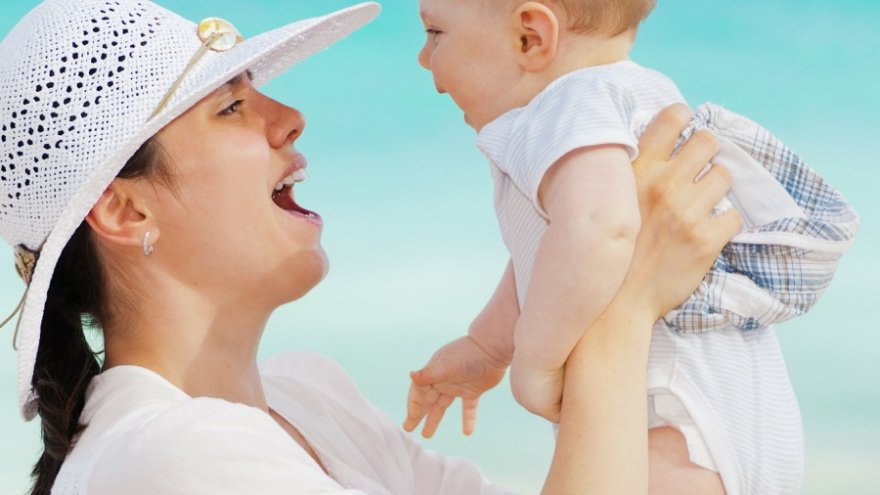Baby Exercises: 3-6 Months

Your baby is starting to come into their own and show you their personality. You are able now to anticipate their moods and know what they like and don’t for the most part. As your baby becomes more active the time you spend playing with them will become more rewarding for both of you.
By the end of 3 months, your baby should have already reached a few exciting milestones like being able to lift their head and hold it stable, making gains in grasping things when they want to, and learning to track objects with their eyes. Using these new skills you can begin to help your baby on a journey to develop their 3 to 6-month milestones.
So much to look at
Your baby is becoming better at tracking and their eyes are getting used to all the fabulous stimulus around them, so it’s a great time to start a habit of reading to your child daily. Pick books that won’t be ruined if your baby decides to grab them and mouth them. Books with high contrast pictures are especially fun during this time. Your baby won’t be able to follow along with a story yet, but listening to you talk can help them learn a language later, so keep going.
It can be fun to take some time to let your baby look in the mirror now. They are still a ways off from recognizing themselves in the mirror, but they will definitely be interested in looking at the “other baby” that they see. Consider getting an unbreakable mirror that is made especially for babies that attaches to their crib or car seat. Letting them have some time to explore their world through their reflection is an entertaining time for both of you.
Touching moments
Your baby is starting to be able to use their hands to grasp things they want to, and a pincer grasp is on the horizon. A pincer grasp is being able to grasp things between the first finger and thumb. This is a great time to help them practice by letting them grasp small items like cereal pieces and other safe to consume bits.
Babies reflexively try to clap their hands but they can’t always make a connection. Help your baby learn to do so by playing clapping games where you help them clap. You can also start to teach your baby how to give a high five, which can be a fun way for them to become more purposeful in the movements of their hands and arms.
While you’re exercising their arms, try helping them learn to stretch and reach by putting a toy just a little bit outside of their reach, or even over their head a little as they sit in a high chair. Getting them to try to reach and grab is a fun game, but make sure you let them win too. Always be positive when they are successful, making it fun to try.
Vocabulary is king during this time period as your baby starts to learn to babble their little brains are ready to learn more words. Using textures to teach your baby soft, squishy, cold, prickly, and other fun words that can be tied to experience is a great way to get more conversations going. Consider ways that you can introduce textures to your baby and be very descriptive of them when you’re doing so. The more you talk to your baby the more words they will begin to recognize, making connections in their brain that they need to learn to talk later.
 Muscle building
Muscle building
Your baby may be super adept at tummy time by now and learning to scoot a bit. Their leg strength is growing and letting them stand and squat on your lap is a great way to help build that stability for them. Continue on with playing games like a bicycle with their legs when they are on their back. Letting your baby learn to press their feet against your hands is a great way to help them exercise those leg muscles.
Strengthening their core muscles is a great exercise for you too. Sit in a chair and balance your baby on your leg and move your leg around in circles. This will help them build strength in their abs and back muscles needed for sitting, crawling and eventually walking, but it also gives you a little bit of weight lifting for your own legs.
Lift your baby up high and then slowly return them to your lap, if they are really good at holding their head stable it can be a great time to play the airplane game, zooming your baby around slowly so they can “fly”.
Tummy time should continue but don’t be surprised if your baby starts to be able to roll from their stomach to their back. It’s normal. Playing around with this new rolling skill can be fun for both of you. Put your baby on a blanket and gently lift it to roll your baby back and forth, swaying. Be careful to make sure that you’re being gentle and slow, and give your baby time to recover and perhaps try to roll themselves a bit.
Watching your baby grow more and more aware of their surroundings and learning to interact more is exciting and rewarding. Make a routine of playing with your baby in a few short sessions every day so they can continue to gain and build on skills they are learning.
By the end of 6 months, your baby should be able to roll over in both directions, support their weight when standing on your lap with your help, begin to be able to sit unassisted for short periods of time and enjoy interacting with people. Pay attention to the games your baby enjoys the most and try to adjust games they don’t like as much to make them more fun for your baby. Keep track of their progress and if you are concerned about your baby’s development speak to your pediatrician about your concerns. Read more about what exercises are best for the 6 – 9 months old babies.






